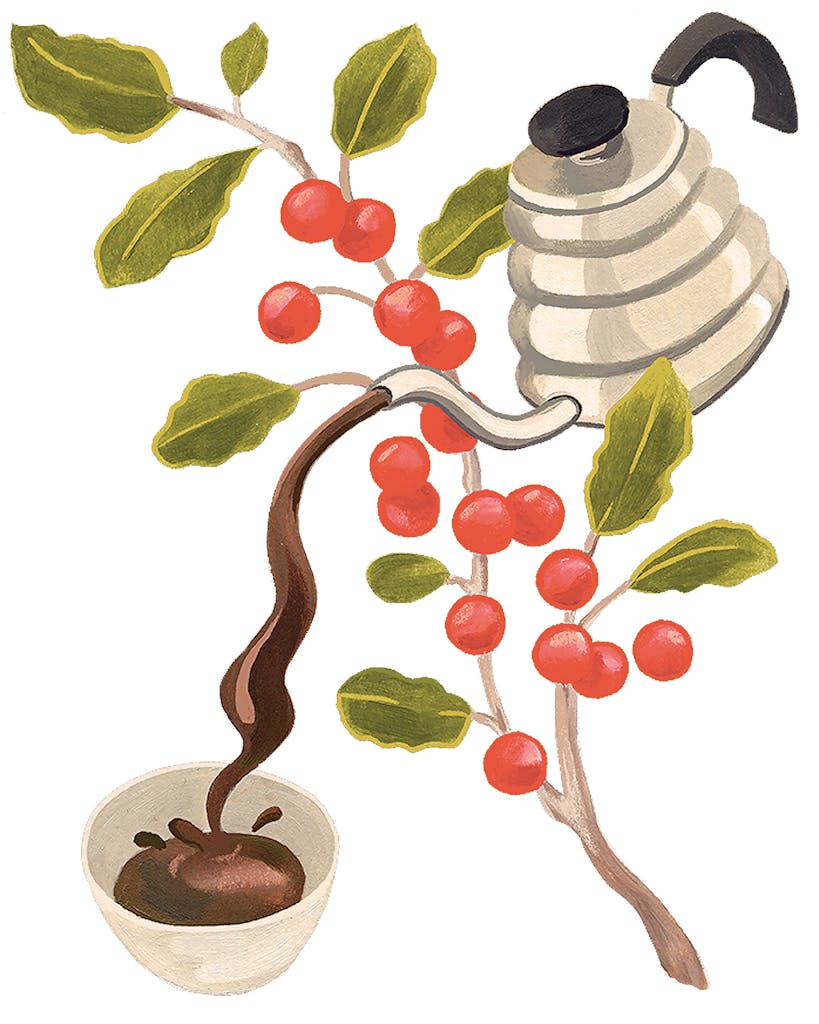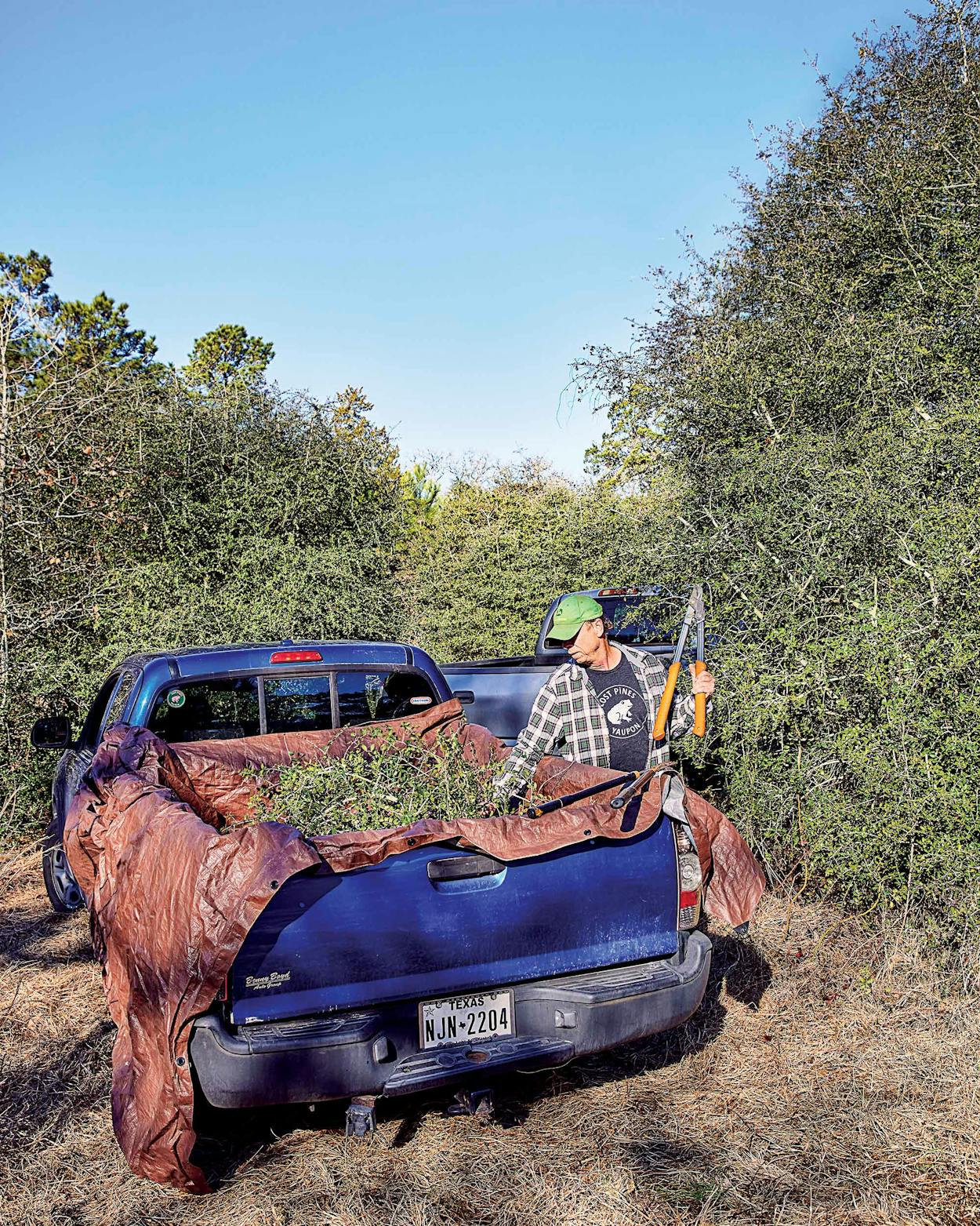Three thick green shrubs stand sentry along my backyard fence. Squat and unassuming, each is about four feet tall, its branches dense with small, scalloped leaves. Seemingly impervious to heat, drought, flood, and freeze, the shrubs grow steadily without any human help. I tend to forget that they exist at all until October, when a cheerful spray of tiny red berries appears. But my humble backyard bushes have a rich history.
The shrubs are yaupon (pronounced “yo-pawn”) holly, the only substantially caffeinated plant native to North America. It flourishes across the Southeast, from the Gulf Coast to Central Texas. Indigenous groups have been drinking tea made from the leaves for more than a thousand years.
In the 1500s, when Spanish explorer Álvar Núñez Cabeza de Vaca traveled across Texas, he noted that members of the tribes he came across drank yaupon. At the time, it was called either “black drink” or cassina and was consumed, Cabeza de Vaca wrote, “as hot as they can stand.” White settlers picked up the habit, and in 1615 a Spanish priest in Florida made a timeless observation about caffeine addiction: “Any day that a Spaniard does not drink it, he feels that he is going to die.”
But sometime between then and the early 1900s, yaupon developed a PR problem. During Native religious ceremonies, worshippers gulped large quantities of yaupon from shell cups, occasionally vomiting afterward. This led British botanist William Aiton to saddle the plant with an unfortunate (and misleading) scientific name: Ilex vomitoria.
Yaupon isn’t an emetic; you’d probably throw up if you drank gallons of water in one sitting too. (It’s also possible that true emetics were sometimes added to the brew.) But the name stuck, and a recent effort by yaupon enthusiasts to change it was unsuccessful.
That yaupon was widely available to harvest for free also likely worked against its image. From the eighteenth to the early twentieth centuries, poor, rural white Americans who couldn’t afford imported tea drank yaupon instead, cementing its low-class reputation. In the forties, pro-yaupon campaigners tried to persuade Americans to give the drink a chance. “During World War II, the U.S. government did a lot of research into yaupon,” says Steve Talcott, a food chemistry professor at Texas A&M University. “Coffee and tea supplies were limited, so they promoted this as an alternative.” These efforts were mostly unsuccessful. Growing turnips in a victory garden was all well and good, but mid-century Americans drew the line at drinking a mysterious brown concoction.
But now, many decades later, the tea is making a comeback.


The plants themselves never disappeared, nor are they likely to. “Yaupon can choke out everything else, and it grows like a thicket,” says Jason Ellis, the cofounder of Lost Pines Yaupon. The company, launched in 2015, makes tea from yaupon plants that its workers clear from private property at no cost to landowners. One August day, I head to Smithville, a town of four thousand near the Lost Pines Forest, an hour’s drive southeast of Austin. A farm-to-market road winds through rolling hills dotted with loblolly pines and post oaks. Here, on a swath of land at the end of a bumpy, overgrown driveway, I find Ellis battling a bush.
“It just goes bonkers,” Ellis says, hauling an armful of yaupon branches over to his Toyota Tundra pickup. He heaps the brush atop an already prodigious pile taller than the truck’s cab and heads back for more.
Wearing long sleeves and gardening gloves for protection from the prickly branches, he wields a long-handled pair of hedge shears and hacks at the base of each plant. The yaupon here dwarfs the shrubs in my yard; some plants are over eight feet tall, and they’ve grown horizontally into one another, creating a nearly impenetrable jungle. In fact, the vast majority of this fifteen-acre property, except for a few areas occupied by trees or grasses, is covered in yaupon.
For centuries, Native Americans in Central Texas used controlled burns to clear out brush—including yaupon—and attract huntable wildlife. “This landscape is supposed to have frequent fires,” Ellis says, “and if you don’t, then you end up with catastrophic fires.” Over the years, as prescribed burns declined, dense, dry brush proliferated and turned into tinder for wildfires; Ellis and his crew’s yaupon removals may help mitigate disasters such as the 2011 Bastrop fire, which consumed 32,000 acres. (Texas Parks and Wildlife and other agencies also conduct controlled burns to mitigate fire risk.)
Thinning out yaupon also allows native grasses to flourish, which helps species such as the endangered Houston toad. The grasses attract insects, and the insects attract toads. Landowners even get a wildlife tax break if they harvest the yaupon on their properties, and they’re typically pleased to have Ellis remove the plants gratis. Ellis, in turn, gets free leaves, which can be picked year-round, for his tea.
The drink may be an ecological and financial win-win, but what does it taste like? “Like green tea and yerba maté had a baby,” Ellis likes to say. I drink my first cup on a summer day in Cat Spring, a small farming community sixty miles west of Houston, at the sunny kitchen table of Abianne Falla, cofounder and CEO of CatSpring Yaupon.
Falla grew up spending summers on her family’s ranch, which is teeming with yaupon. During the scorching drought of 2011—the driest recorded year in Texas history—Falla noticed that the plant was one of only a few still alive on the property. “I’d like to say I knew it would be big,” she says, “but really, I was just curious why it was still growing.” Together with her sister, Jenna Dee Detro, she turned to the internet. “We uncovered this forgotten legacy of Indigenous people who’d had a tradition of drinking yaupon for centuries, and we were like, ‘Why is this not commercially available?’ ”
related video:
Watch Texas Country Reporter’s interview with Abianne Falla and Jenna Dee Detro, founders of CatSpring Yaupon.
Following YouTube tutorials, the sisters roasted tea leaves on baking sheets in their home kitchen. They launched CatSpring later that year, a vanguard in a handful of Texas businesses working to take yaupon mainstream. Soon its hot and iced teas were on the menus of hip restaurants like Dai Due, in Austin, and Supper at Hotel Emma, in San Antonio. Today you can even buy Rambler sparkling water and Greenbelt Kombucha infused with CatSpring yaupon; Central Market sells their loose-leaf tea. Over the past decade, Falla has seen more Texans give the unfamiliar beverage a try—though many remain skeptical, especially those who have known yaupon only as a nuisance weed. At one farmers’ market, she recalls, a rancher told her a local joke: “You know why I call it yaupon? Because I’m glad it’s yo-pon and not my-pon!”
As I sip the greenish tea Falla has brewed (CatSpring sells medium and dark roasts, as well as unroasted green yaupon), I wonder if a taste of the stuff might’ve changed the rancher’s mind. The flavor is similar to green tea but milder, with delicate herbal notes. Ellis’s comparison to yerba maté is apt, though yaupon has just a hint of maté’s grassy flavor. Yaupon lacks tannins, so it’s impossible to over-steep the leaves. And unlike with coffee, you won’t get jittery if you drink a lot of it; the amount of caffeine makes for a gentle buzz.
Yaupon also contains antioxidants called polyphenols, which have anti-inflammatory and possible cancer-preventing properties. Talcott, who has studied the plant’s health benefits, believes it could become a trendy coffee alternative. “I think the potential is huge,” he says. “Look at how much the yerba maté market has grown. The challenge is in educating people.”
Yaupon enthusiasts believe they can meet that challenge. “I don’t think it’s naive to think yaupon will be a billion-dollar industry in Texas in five years,” Falla tells me. In addition to CatSpring and Lost Pines, which offer yaupon concentrate in a wide range of flavors, Texas is home to YAYAYA Yaupon and Local Leaf, both based in Austin. The latter specializes in yaupon matcha, a powder that can be blended into ice cream and smoothies, while YAYAYA sells bottled drinks in flavors such as lavender-honey. And for those who prefer a tipple to a tea, Treaty Oak Distilling adds yaupon notes to one of its Waterloo gins.
Some Native communities in Texas still drink yaupon during ceremonies, though the practice is less common than it once was. When Ron Trussell, the 72-year-old principal chief of the Tsalagiyi Nvdagi Cherokee tribe, was growing up, he was unaware of yaupon; he learned about it later in life, through word of mouth and his own research. “A lot of our culture has been lost, so we’re still learning,” says Trussell, who lives in Waco. “Now we’re teaching our younger generation about it.” At the Tsalagiyi Nvdagi’s annual celebration every October, on tribal land near the East Texas town of Troup, members drink yaupon as part of the Stomp Dance. “The dance is an all-night ceremony, so in order to keep up, you need to have this stimulant,” he says. “We brew it really strong.”
Each tribe has its own yaupon tradition. Absolem Yetzirah, who lives in Houston and is a council member of the Karankawa Kadla, says the tribe uses the plant’s berries to make red face paint and might serve yaupon tea to a member who is sick, “or maybe if you needed to receive a message from an ancestor.”
Yetzirah is unperturbed by non-Indigenous Texans’ newfound interest in the plant. “It belongs to all people who drink it,” Yetzirah says. “But I’m going to laugh at anybody who buys this thing, because it grows natural and wild all over the place.”
It’s easy to make your own tea. One morning, I shear a few branches from the yaupon plants in my backyard. I pluck off the leaves, wash them, and spread them in a thin layer on an unlined cookie sheet. Then I bake them at 350 degrees for twenty minutes. (Roast the leaves longer than that and you’ll get a stronger flavor that’s closer to black tea than green tea.)
My kitchen fills with the same pleasant, faintly herbal aroma I’d noticed when I visited the CatSprings and Lost Pines warehouses. After checking the oven frequently to make sure the leaves hadn’t caught fire—“I learned that lesson the hard way,” Ellis had warned—I remove the baking sheet and let it cool to room temperature. Then I crumble the leaves in my fingers, place a teaspoonful in a tea ball, add it to a mug of hot water, let it steep for a few minutes, and sip the tea slowly while easing into my workday. With a little honey and a mint leaf stirred in, the tea tastes just as good as any of the packaged yaupon products I’ve tried. It might be my imagination, but I feel alert in a calm way, without the comedown that usually follows my morning coffee. The leftover leaves now wait in a jam jar on the kitchen counter, ready for the next time I need a pick-me-up.

Let loose (leaf) with these four Texas yaupon brands.
CatSpring Yaupon
Based in: Cat Spring
Year founded: 2011
Standout product: Loose-leaf tea and tea bags in green, medium, and dark roasts—or try a sampler pack of all three.
Local Leaf
Based in: Austin
Year founded: 2016
Standout product: Yaupon matcha, a finely ground powder that can be blended into ice cream, baked goods, and other treats.
Lost Pines Yaupon Tea
Based in: Austin
Year founded: 2015
Standout product: Tea concentrate, which can be prepared hot or iced, available in six fruity flavors.
YAYAYA Yaupon
Based in: Austin
Year founded: 2019
Standout product: Bottled iced teas in four herbal flavors.
This article originally appeared in the April 2022 issue of Texas Monthly with the headline “Steeped in History.” Subscribe today.









